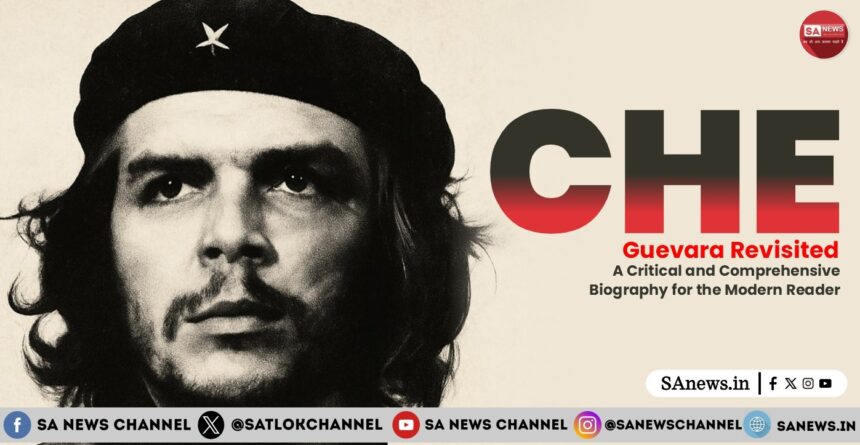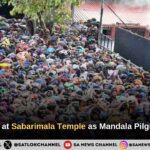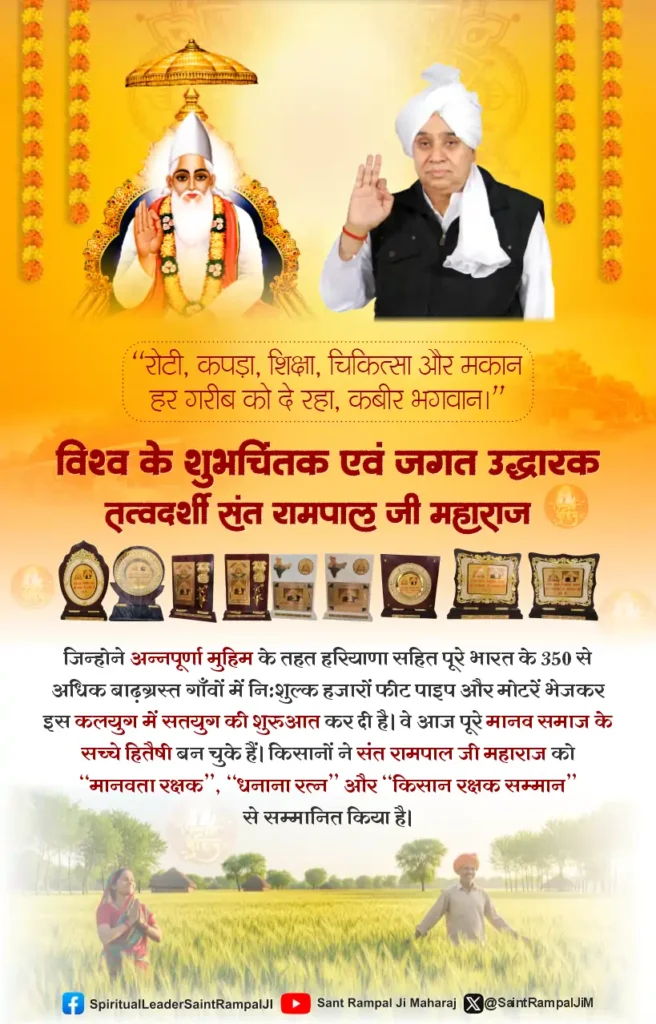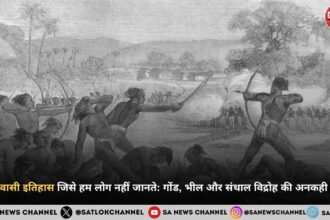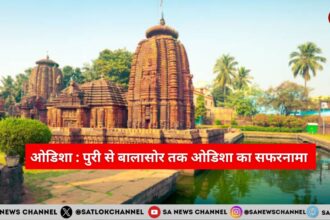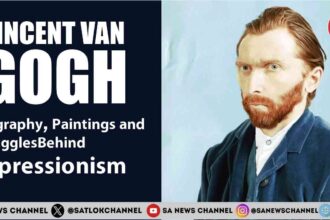Ernesto ‘Che’ Guevara remains one of the most iconic and polarising figures of the twentieth century. Che was a man whose face became a global symbol long after his body was laid to rest in an unmarked grave in Bolivia. Understanding Che Guevara requires piercing through the mythology that surrounds him, both triumphant and damning, and tracing the emotional, intellectual and political currents that shaped his extraordinary, turbulent journey. This short biography of Che Guevara endeavours to present his life in a never-explored-before perspective.
- Who is Che Guevara?
- Che Guevara’s Education
- Che Guevara’s Ideological Awakening: The Motorcycle Journey That Changed Everything
- Che Guevara and The Cuban Revolution
- Che Guevara In Power: Political Roles in Cuba
- The Bolivian Campaign: Strategy, Miscalculations and Capture
- Repression and Controversial Actions of Che Guevara
- Che Guevara’s Writings and Military Theory
- Che Guevara: Iconography and Cultural Afterlife
- Polarising Views: Why Many Condemn Che Guevara
- Polarising Views: Why Many Revere Che Guevara
- Why Che Guevara and Simón Bolívar Echo One Another
- What History’s Greatest Rebels Couldn’t See
- The Spiritual Blind Spot in Che Guevara’s Mission for Justice
- FAQs
Who is Che Guevara?
Before embarking on this exploitation, it is important to understand the scope of this article. While there is immense information and critique about Che Guevara available already, this article attempts to present him not as a caricature. Instead, it aims to explore Che Guevara’s complexities as a human being shaped by his context, situations, ideologies, convictions and sufferings.
The extreme divide of opinion about Che Guevara from geography to geography also weighs heavily on the unstable and uneven geopolitical situation that existed in South America. For example, while Cuba and Venezuela consider Che Guevara as their hero, countries like Mexico hold mixed opinions about him. Relations of a country with the USA play an important role in the overall perception of Che Guevara as a revolutionary or a tyrant.
The bone of contention here being that most critical thinkers of Latin America, including Che Guevara, believed that the poverty and slow development of Latin America was due to countries like the United States of America exploiting them and their abundant natural resources. Che Guevara aimed to end this exploitation, especially by America’s CIA-driven motives.
The Early Life of Che Guevara
Born in 1928 into an upper middle-class, liberal Argentine household in Rosario, Che Guevara’s original name was Ernesto as he was customarily named after his father. Ernesto Guevara de la Serna adopted the name Che much later in his life.
Che Guevara was the first-born to Ernesto Guevara Lynch, an architect-builder and entrepreneur, and Celia de la Serna y Llosa. He had four more siblings. Financially, he didn’t see any struggle in his childhood. His parents were liberal, fiercely anti-authoritarian and sympathetic to the Republican cause in the Spanish Civil War. His mother was educated, outspoken and radically independent for her generation. Che’s parents wanted all their children to learn the harsh realities of life from their own experiences.
Ernesto ‘Che’ Guevara spent much of his childhood confined indoors with crippling asthma. Yet this physical limitation inadvertently became his gateway into a voracious intellectual life. Surrounded by book shelves that housed everything from Marx to Neruda, from Freud to Kafka, young Ernesto developed an early affinity for abstract thought and a deep sensitivity to suffering. These early exposures shaped Che long before ideology entered his life.
Asthma made him an observer. While other children played outside, he read obsessively. He once joked that his illness ‘made me a philosopher by force’. But, as experts point out, this confinement also forged one of his defining traits – a mind that analysed suffering not abstractly but intimately, because he himself lived trapped in a body that resisted him.
Che Guevara’s mother was the prime influential figure in his growing up days. She encouraged him to become a voracious reader. His parents encouraged free thinking, and this produced a boy who questioned everything, including religion, political authority, social norms and even his own limits. His grandmother, Ana Isabel Lynch, was another figure young Ernesto was emotionally very close to.
Che Guevara’s Education
Che initially chose engineering as his field of study post schooling. However, after the death of his very dear grandmother, he shifted tracks from engineering to medicine at the University of Buenos Aires. It is also believed that Che Guevara studied medicine determined to find a cure for his own asthma, though family members also felt that the decision was triggered by the death of his grandmother.
One of the least-discussed psychological roots of Che’s personality is his lifelong belief that human life must be bent into coherence, into meaning, into justice. Illness taught him fragility and literature taught him dignity. Together, they created a moral absolutist – someone unable to look at injustice and shrug.
His medical studies further strengthened this impulse. He was not merely studying the body, he was studying the structural causes of pain, inequality and exclusion. These foundations are believed to have shaped both the humanitarian tenderness in his writings and the ruthless resolve in his politics.
Che Guevara’s Ideological Awakening: The Motorcycle Journey That Changed Everything
In December 1951, Che Guevara embarked on a motorcycle expedition across South America with his friend Alberto Granado. What he encountered on this journey broke open the sheltered world of an Argentine student.
- Travelling through Chile, Peru and Colombia, Che Guevara witnessed a continent fractured by inequality and haunted by the remnants of colonial structures.
- He met copper miners living in semi-slavery.
- He saw Indigenous communities dispossessed of their land and dignity.
- He spent nights in leper colonies where patients were segregated not because of medical necessity but social stigma. They were separated like ghosts.
- He saw miners working in inhuman conditions and peasants trapped in hopeless poverty.
- He wrote, ‘I am not the same person I was. I can no longer be indifferent’.
- This journey revealed the great contradiction of Latin America – beauty and brutality side by side.
Che Guevara’s travels across Latin America were not simply geographical journeys. They were transformative experiences that sharpened his moral compass. Through miners, lepers, farmers and displaced communities, he witnessed the everyday violence of poverty – a violence so constant that people no longer recognised it as such. These encounters functioned as his political awakening, but more profoundly, they acted as a spiritual rupture. His indignation was not abstract but embodied. Che inhaled injustice as though it were a pollutant suffocating the continent. This is why, critics point out, he later wrote with such urgency and moral absolutism. He was not theorising suffering, he had lived in its shadows.
Unlike many revolutionaries whose ideas hardened early in life, Che’s thinking expanded dramatically over the years. He was constantly adjusting, questioning, and refining his worldview. His belief in radical change did not stem from dogma but from a continuous, almost obsessive, search for coherence between theory and reality. This has been extensively observed in his writings. Even while riding on trucks or waiting in remote villages, he filled pages with thoughts on justice, political structures, and the moral duty of the privileged.
Che Guevara’s father later remarked that it was this motorcycle journey that ‘had convinced him of his true destiny’. For Che, this was not a political awakening, it was a moral shock. He wrote in his diary, ‘I am no longer the same person. The division of America into unstable fragments diminishes us all’.
This line captures the seeds of a worldview that would later bloom into his most radical conviction that Latin America’s suffering was fundamentally one fabric, one wound, one history. Therefore it required one liberation.
Che Guevara came to view poverty not as a social problem but as an existential violence inflicted upon millions.
Che Guevara and The Cuban Revolution
Che Guevara’s political transformation occurred not in Cuba, but in Guatemala City in 1954, when the CIA-backed coup overthrew the democratic government of Jacobo Árbenz. Che, then a young doctor, witnessed how foreign corporate interests and U.S. strategic policy could topple a government attempting land reform.
This was Che’s initiation into the geopolitics of the Cold War and his writings from this period are among the least known yet most revealing. He concluded that democratic reforms were insufficient in the face of entrenched power. Structural injustice, he believed, required structural confrontation.
Meeting Fidel and Raúl Castro in Mexico in 1955 completed the transformation where they and other exiles organised the 26th of July Movement to overthrow Fulgencio Batista in Cuba. Che did not join the Cuban revolution out of nationalism. In fact, he was Argentinian. He joined the Cuban revolution because he saw Cuba as a laboratory where Latin America’s historical wounds could be healed.
As a guerrilla commander, the Argentine doctor quickly distinguished himself by his discipline, intellect and severe moral conviction. During the guerrilla struggle in the Sierra Maestra, Che became respected and feared for his absolute refusal to accept laziness, cowardice or self-interest.
He displayed both tenderness and ruthlessness. He treated the wounded with compassion but enforced discipline without hesitation. Che Guevara’s biography reveals that the dual role as a doctor and warrior symbolised his internal struggle – a man drawn equally to healing and to confrontation.
Contemporary accounts from comrades note that Che was often awake before dawn, writing, training or studying tactics. His desire to embody the revolution through personal sacrifice made him a natural moral centre of the group, even if he was not the most charismatic among them.
When the revolution succeeded, few expected Che to leave the battlefield for an office. Yet that is precisely where his next fight lay.
Che Guevara In Power: Political Roles in Cuba
After victory in 1959, Che became one of the most influential figures in Fidel Castro’s government. He occupied key roles such as President of the National Bank, Minister of Industries and chief architect of Cuba’s early socialist economic model.
Che Guevara’s Economic Ideas and Bureaucratic Conflicts
Che Guevara’s vision for socialist construction diverged sharply from the pragmatic approaches favoured by many of his contemporaries. He distrusted material incentives and believed that true socialism required a transformation of human consciousness. In his model, workers would be driven by collective purpose rather than personal gain – an aspiration embodied in his ideal of the ‘new socialist man’. This figure would labour not for wages, but from moral conviction and revolutionary duty.
Che’s psychology clashed with the realities of governance. As with all Che Guevara actions, there are contradicting views for this too. Critics argue that this vision was naive and economically damaging. Admirers counter that he was building a new ethical model for society.
This philosophy placed Che at odds with the emerging technocratic wing of the Cuban administration:
- While he advocated strict labour discipline, centrally planned production and mass voluntary work brigades, others pushed for cautious market mechanisms, managerial expertise and gradual institutional consolidation.
- The resulting friction made daily governance increasingly suffocating for Che.
- He found himself struggling against entrenched bureaucracy, ideological fatigue, and the compromises of state-building.
- It is within this context that his gradual withdrawal from political office makes sense.
- Che Guevara believed that the revolution risked stagnation if it became confined to administrative routines.
For him, the true battleground was still abroad where global inequalities persisted and guerrilla struggles awaited support. Historians continue to debate whether his departure reflected principled internationalism or disillusionment with the Cuban system.
International Missions and the Congo
In the years following the Cuban Revolution, Guevara became a symbolic envoy for the new socialist state.
- He travelled widely across the socialist bloc.
- He spoke at the United Nations in 1964 and cultivated diplomatic relations while maintaining a relentless critique of global inequality. But diplomacy alone could not satisfy him.
- His most audacious foreign intervention occurred in the Congo in 1965, where he led a clandestine Cuban mission to assist anti-colonial rebels.
- The experience exposed a painful disconnect between theory and reality.
- Che’s vision of a disciplined guerrilla foco of small, committed groups sparking wider revolution collapsed against the fragmented politics, tribal divisions and weak organisational structures of the region.
The Congo campaign left a deep impression on him. The private notes he kept during this period reveal a man confronting the limits of his own doctrine. He wrote with frustration, introspection and a renewed sense of the moral cost of failure. The lessons he drew from this mission shaped his thinking in Bolivia, though many of those lessons proved difficult to apply under the conditions he later faced.
This period also marks the paradox at the heart of Che Guevara where he fought for the poor with immense love, but governed with a severity that some describe as authoritarian. Che was, in a sense, attempting what Simón Bolívar had attempted earlier: the creation of a collective identity that could overcome internal fragmentation.
The Bolivian Campaign: Strategy, Miscalculations and Capture
Bolivia became Che Guevara’s final theatre of struggle and arguably, his most tragic. A timeline of his Bolivian Campaign:
- He entered the country in 1966 with the ambition of igniting a continental uprising, imagining Bolivia as a strategic heart from which revolution could radiate across Latin America. But the campaign faltered from the outset.
- Che’s guerrilla force was small, his support network weak and his understanding of local dynamics limited.
- Language barriers restricted communication with the rural communities whose support he desperately needed, as he did not speak Quechua.
- Moreover, the Bolivian Communist Party, which he expected to be an ally, refused full cooperation.
- Compounding these problems was an adversary far more capable than he anticipated. The Bolivian military, assisted by U.S. advisers, CIA intelligence and specialised anti-insurgency training, effectively tracked and isolated Che’s guerrilla column.
- Declassified documents reveal the extent of the U.S. role in monitoring his movements and coordinating with Bolivian forces.
- On 8th October 1967, Guevara was captured after a firefight in the Quebrada del Yuro.
- He was executed the next day in La Higuera on 9th October 1967.
- The subsequent public display of his body in Vallegrande was arranged to prove he was truly dead.
Experts believe this public display transformed him into a martyr in the public eye.
Repression and Controversial Actions of Che Guevara
A fully honest account of Che Guevara’s life must confront the more troubling aspects of his revolutionary conduct.
- During the first years after the Cuban Revolution, Che played a direct role in overseeing tribunals at La Cabaña and participated in campaigns to discipline labour and suppress counter-revolutionary activity.
- He believed firmly that the revolution required firmness and, at times, swift punitive action.
- Eyewitness testimonies and archival records present a mixed picture – one of moral earnestness intertwined with the conviction that violence was justified to protect the revolution’s survival.
- Critics argue that he presided over summary executions and tolerated abuses in the name of ideological purity.
- Defenders counter that these actions occurred within the fraught context of a collapsing dictatorship, armed resistance and foreign threats.
The historical consensus acknowledges both Che’s idealistic motivations and his readiness to employ ruthless measures when he believed the revolutionary cause demanded it.
Che Guevara’s Writings and Military Theory
Beyond his public actions, Che was an extraordinarily prolific writer, as has already been discussed in this article. His works, ranging from political essays and economic critiques to guerrilla manuals and private correspondence, constitute one of the most substantial intellectual writings of any modern revolutionary.
- His book ‘Guerrilla Warfare’ became a reference text for insurgent movements across Africa, Asia and Latin America.
- However, it is his lesser-known writings that are perhaps more revealing.
- His diaries from the Congo and Bolivia, his letters to family and his annotated notebooks show a thinker grappling with doubt, responsibility and loneliness.
- They reveal that behind the confident strategist was a man who questioned the cost of his mission and the solitude that accompanied it.
These private reflections challenge the simplistic portrayals of Che as either a romantic icon or a ruthless ideologue. Instead, they reveal a mind constantly negotiating between moral rigor and human vulnerability.
Che Guevara: Iconography and Cultural Afterlife
No account of Che Guevara is complete without recognising the extraordinary cultural afterlife of his image. Some notable points regarding this subject are:
- The photograph ‘Guerrillero Heroico’, taken by Alberto Korda in 1960, became one of the most reproduced images in modern history.
- Ironically, Guevara himself never sought such immortality and Korda never intended the photograph to be a global symbol.
- Yet they have been and still are reproduced on posters, flags, murals and clothing.
- Che’s stylised visage evolved into an emblem of youthful rebellion, anti-establishment sentiment and global solidarity.
- However, it is extremely important to note here that Che Guevara’s image of him smoking is also viewed as iconic, soft influencing youth to view smoking as ‘cool’ and ‘revolutionary’. In reality, it promotes vulnerable young minds to accept a vice as part of their lifestyle.
- The Constitution of God classifies smoking as a grave sin and ensures severe consequences to this action.
Polarising Views: Why Many Condemn Che Guevara
Che Guevara’s critics argue that behind the romantic icon lies a man who embraced violence as a political tool and helped construct a repressive system in Cuba. Here are a few insights into the negative perceptions about Che Guevara:
- Critics highlight his role in revolutionary tribunals and executions at La Cabaña prison, which they claim lacked due process and reflected an uncompromising zeal.
- To them, Che represents an authoritarian impulse within leftist movements, a figure who prioritised ideology over individual rights.
- His economic policies were influenced by moral idealism rather than practical economics.
- They are seen as contributing to Cuba’s long-term economic challenges.
- His insistence on self-sacrifice and collectivism is often interpreted as coercive.
- Meanwhile, his attempts to export revolution to the Congo and Bolivia are criticised for destabilising already fragile regions.
- As pointed out earlier, vulnerable youth, who flaunt Che Guevara’s picture on their T-shirts, are also soft-influenced into smoking in a bid to mimic their idol. Jagatguru Tatvdarshi Sant Rampal Ji Maharaj divulges that consequences of such vices are severe and extend beyond a single lifetime.
For critics, Che is a cautionary figure – a reminder that noble intentions can become destructive when enforced without restraint or democratic safeguards.
Polarising Views: Why Many Revere Che Guevara
Conversely, Che’s admirers view him as a man of rare integrity, someone who refused to live comfortably in a world of inequality. Here are the aspects of Che Guevara admired by his supporters:
- Supporters respect his unwavering conviction, his willingness to sacrifice privilege for the oppressed and his rejection of personal power.
- To them, Che’s life embodies moral consistency because he lived the ideas he professed.
- His anti-imperialist stance resonates deeply in regions that experienced foreign domination.
- Che’s writings on solidarity, racism and economic injustice influenced generations of activists.
- Even those who disagree with his Marxism often admire the courage and sincerity with which he pursued his ideals.
- Che’s early diaries reveal a profoundly empathetic young man whose revolutionary path was driven less by hatred of the powerful and more by compassion for the powerless.
For his supporters, Che symbolises the global struggle for dignity and a reminder that ordinary people can challenge entrenched injustice and imagine a fairer future.
Why Che Guevara and Simón Bolívar Echo One Another
Coming thus far in this analysis, one cannot help but notice similarities in the journeys of Che Guevara and Simón Bolívar. The psychological resonance between Che Guevara and Simón Bolívar is one of the most fascinating, underexplored parallels in Latin American history.
- Both men were shaped by a continent steeped in injustice, fragmentation and foreign control.
- They came from different centuries and backgrounds, yet their internal landscapes were strikingly aligned.
- Bolívar, the aristocrat-turned-liberator, saw Latin America not as a collection of nations but as a civilisation seeking unity.
- On the other hand, Che, the doctor-turned-revolutionary, saw Latin America not as separate republics but as one wounded body.
- Both men believed that the destiny of the continent was collective, not national. And both were tormented by a lifelong conflict between idealism and reality.
- Bolívar liberated nations but died disillusioned.
- Che ignited revolutions but died before seeing them take shape.
- Bolívar dreamt of a unified Latin America and Che dreamt of a liberated Latin America.
- Their personal writings reveal similar psychological traits of an intolerance for injustice, a belief in continental unity, a near-religious sense of mission, a willingness to sacrifice their lives, and a tragic awareness of their own solitude.
Both men were loved and hated. Both were mythologised and demonised. And both, in the end, became symbols of imperfect humans passionate for a continent still struggling with the very wounds they tried to heal.
What History’s Greatest Rebels Couldn’t See
Though parallels between Simón Bolívar and Che Guevara are often drawn, the most revealing and shocking insight is frequently overlooked. Both men, separated by more than a century, were driven by the same wound – the sight of profound injustice. Bolívar fought to liberate a continent whereas Guevara fought to reshape it.
And yet, despite their resolve, brilliance and sacrifice, neither could create the just world they envisioned. This pattern of reform, resistance, revolution and recurring injustice, raises a deeper question we rarely dare to ask.
Why does injustice exist at all? What is its origin? Why do human beings, generation after generation, keep fighting the same battles?
Humanity is so accustomed to confronting injustice that we almost never question its source. If the world we live in were truly governed by the Supreme God, would it not reflect divine fairness? Would not every soul live in a world aligned with justice rather than suffering?
Jagatguru Tatvdarshi Sant Rampal Ji Maharaj offers an explanation that reframes this entire dilemma. He reveals that we have normalised pain, cruelty and hardship to such an extent that we no longer recognise them as abnormal. We accept exploitation as ‘reality’, conflict as ‘nature’, and suffering as ‘the human condition’. We never pause to see that these are signs of a world fundamentally out of alignment with true divinity.
He reveals that the root of injustice is not political but cosmic. We live in a realm governed by Kaal Brahm (Satan), the ruler of this material world. Thus, injustice is not accidental, it is a feature of this domain.
From this perspective, Bolívar’s failure, Guevara’s struggle and the endless cycles of worldly revolution all point to a single truth: No earthly system can eradicate injustice because its origin lies beyond earthly structures. Only by understanding the True Creator and the true nature of this world can humanity finally diagnose the pattern it has been trapped in for centuries.
The Spiritual Blind Spot in Che Guevara’s Mission for Justice
Che Guevara lived and died convinced that the world’s suffering was entirely man-made, that injustice flowed from corrupt systems, and that the cure demanded relentless human action. To him, life was a battlefield divided between oppressors and the oppressed, and he firmly stood beside those he believed had been wronged.
But Jagatguru Tatvdarshi Sant Rampal Ji Maharaj reveals a truth that transforms the very foundation of this struggle. He exposes the satanic power controlling this material world and explains why no amount of political upheaval or revolutionary courage can ever lead to true liberation. This realm is part of the 21-universe domain governed by Kaal Brahm, known across scriptures as Satan. It is not our true home. Every soul living here arrived due to a grave mistake and since then, has been trapped in a realm fundamentally designed to generate suffering.
For this reason, suffering is not merely social, political or economic, it is cosmological. Sant Rampal Ji Maharaj shares that the scriptures describe this world as ‘Dukhalay’ or a world of sorrows because its ruler thrives on chaos, conflict and karmic entanglement.
Sant Rampal Ji Maharaj further explains that all worldly revolutions, whether led by Bolívar, Guevara or any other visionary, can do nothing more than reshuffle this suffering. The oppressed rise, the oppressors fall, and in time their roles reverse. Every action here creates karmic bondage, and these bondages cannot be destroyed by ideology, bravery or sacrifice. They dissolve only through worship of Supreme God Kabir, received from a Tatvdarshi (Complete) Sant.
Che Guevara could never understand this truth as he lacked the one key that reveals this hidden structure – the refuge of a Tatvdarshi Sant.
Why did Che Guevara and other revolutionists live with a constant sense of incompleteness, a hunger for a purer world? He crossed continents seeking a victory that forever eluded him. This restlessness is the soul’s innate longing for its true, eternal home ‘Satlok’ – the eternal and flawless abode of Supreme God Kabir, where no one dies, no one suffers, and all souls live in harmony with inexhaustible resources.
An outward search for the justice and peace that lies only in the higher realm where the Supreme God resides is possible only through the worship granted by Jagatguru Tatvdarshi Sant Rampal Ji Maharaj. Learn more by visiting:
- Website: www.jagatgururampalji.org
- YouTube: Sant Rampal Ji Maharaj
- Facebook page: Spiritual Leader Saint Rampal Ji
- X Handle: @SaintRampalJiM
FAQs
Q1. Who was Che Guevara and why does he matter in history?
Answer: Che Guevara was an Argentine-born revolutionary who helped shape the Cuban Revolution and became a global symbol of rebellion, anti-imperialism and radical political change.
Q2. Why is Che Guevara seen as a controversial figure?
Answer: He remains divisive because admirers praise his fight against injustice, while critics highlight his role in strict revolutionary trials and uncompromising use of violence.
Q3. What core ideology did Che Guevara believe in?
Answer: Guevara supported Marxist-Leninist ideas, calling for worldwide revolution, resistance to imperial power and the creation of a morally disciplined socialist society.


